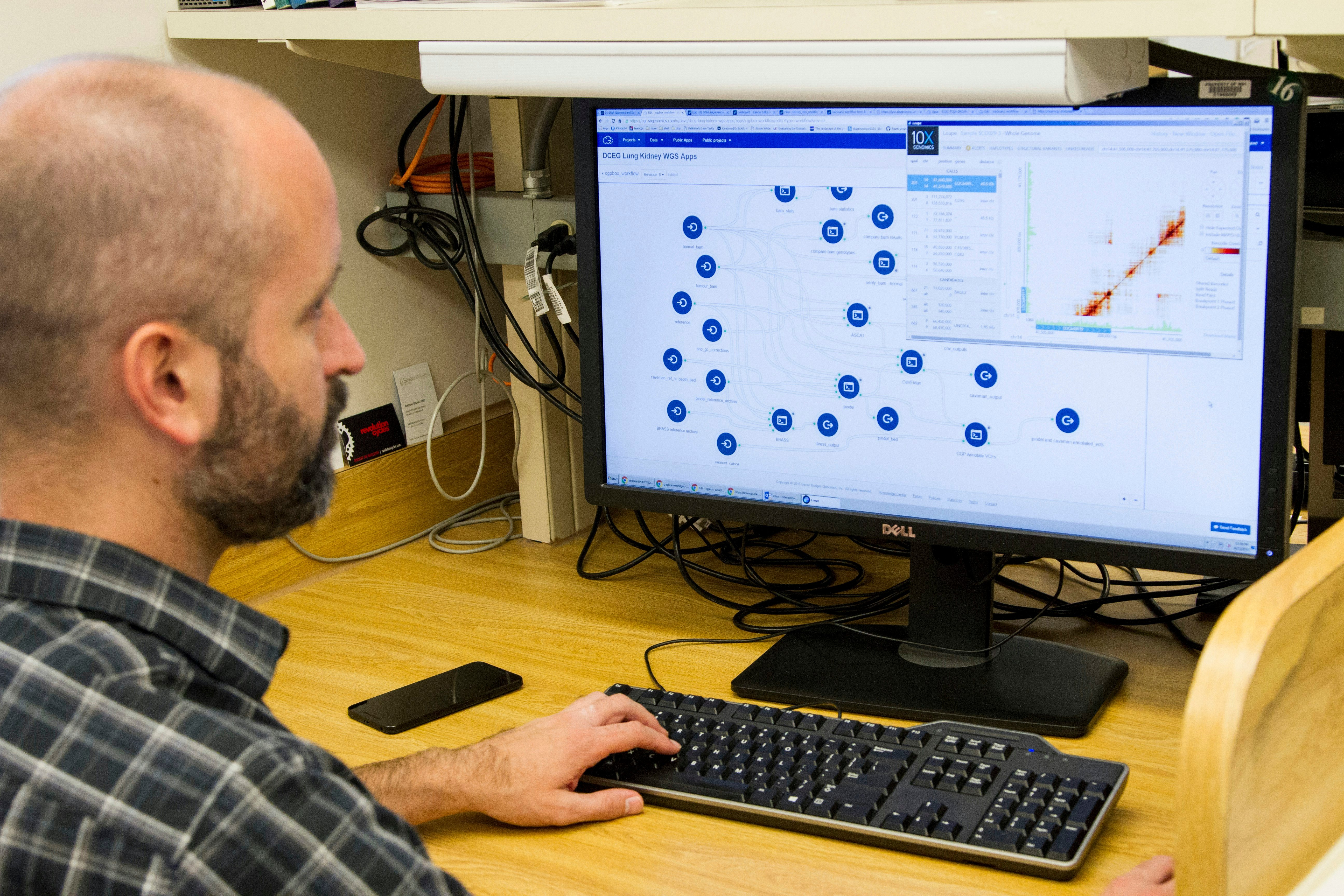
HIV Vaccine Trials Pave Way to Broad Antibody Success
LA JOLLA, CA and NEW YORK, NY—A decades-long scientific challenge in HIV vaccine development has been finding a way to train the immune system to produce antibodies that can target many variants of the virus. Traditional approaches haven’t worked—largely because HIV mutates rapidly and hides key parts of itself from the immune system.
Now, a new study combining data from two separate phase 1 clinical trials shows that a targeted vaccine strategy can successfully activate early immune responses relevant to HIV, and, in one trial, further advance them—a key step toward a long-sought goal in vaccine development. Conducted by an international team led by scientists at IAVI and Scripps Research, the trials included nearly 80 participants from both North America and Africa, laying essential groundwork for a future HIV vaccine with global potential. The study was published in Science on May 15, 2025.
One of the trials tested a stepwise vaccination strategy, in which a priming dose and a distinct booster dose were given sequentially to guide the immune system through stages of antibody development. That trial demonstrated that administering this combination—a technique known as heterologous boosting—could further advance the immune response in humans. The second trial focused on the priming stage and showed that an initial vaccine dose could successfully activate the desired immune cells in African participants, supporting the use of this approach in regions most affected by HIV. In both trials, the vaccines were delivered using an mRNA-based vaccine platform—similar to the technology used in the COVID-19 vaccines—which enabled faster production and clinical testing, and provided strong immune responses.
“We’ve now shown in humans that we can initiate the desired immune response with one shot and then drive the response further forward with a different second shot. We’ve also shown that the first shot can work well in African populations,” says senior author William Schief , a professor of immunology and microbiology at Scripps Research; vice president for protein design in infectious disease research at Moderna, Inc.; and executive director of vaccine design at IAVI’s Neutralizing Antibody Center. “These trials provide proof of concept for a stepwise approach to elicit custom-tailored responses—not just for our vaccine, but for the vaccine field at large, including non-HIV vaccines.”
“These remarkable results validate the rational vaccine design that underpins this approach,” adds Mark Feinberg, President and CEO of IAVI. “A vaccine would be a tremendous step forward for global health and could help bring an end to the HIV pandemic. This effort has been made possible by a phenomenal collaboration of scientific research institutions, funders, private sector and government—and is a testament to the power of partnership-driven scientific inquiry.”
Broadly neutralizing antibodies, or bnAbs, are a rare type of immune defense that can recognize and block a wide range of HIV variants. Unlike standard antibodies, which often only recognize a specific variant of the virus, bnAbs target parts of HIV that stay the same even as the virus mutates. Scientists have long viewed bnAbs as the immune system’s best shot at preventing HIV infection.
The first step in helping the body produce bnAbs is through what’s known as a priming vaccine—an initial dose designed to activate rare, naïve B cells with the potential to eventually produce bnAbs. This approach is called germline targeting. B cells are a type of white blood cell that play a central role in the immune system by making antibodies that recognize and fight off viruses and other threats. Later vaccine doses, known as boosters, guide those cells through a process of maturation toward producing HIV-targeting antibodies. Even though these trials weren’t intended to generate bnAbs themselves, they demonstrated that the vaccine strategy to deliver a series of different shots to guide the immune system to produce bnAbs has great promise.
Targeting the right cells at the right time
This work builds on two key lines of earlier research emerging from Schief’s lab: results published in 2022 from the IAVI G001 clinical trial , which showed how a protein-based vaccine could successfully activate the rare immune cells needed to initiate bnAb development, and a series of four preclinical studies published in 2024 that demonstrated how a multi-step vaccination strategy could guide the immune system toward producing protective antibodies.
The new study analyzed data from two distinct phase 1 clinical trials: the IAVI G002 trial, conducted in North America, and the IAVI G003 trial, conducted specifically in South Africa and Rwanda—countries that are among the most affected by HIV in sub-Saharan Africa. G002 enrolled 60 participants, while G003 enrolled 18. Both trials used germline targeting.
In G002, participants received either the priming vaccine alone or the priming vaccine followed by a slightly different booster—the latter being the heterologous boosting strategy. This two-step process is designed to guide the immune response further along the path toward bnAb development by generating VRC01-class antibodies—early immune defenses with key features of bnAbs. Named after a well-studied bnAb that neutralizes a wide range of HIV variants, VRC01-class antibodies block HIV from binding to a host cell’s entry receptor by targeting a region of HIV that rarely changes, despite the virus’s rapid mutation. Thus, these antibodies are considered among the most promising leads in HIV vaccine development.
All 17 participants in G002 who received both the priming vaccine and the booster developed VRC01-class responses, and more than 80% of them showed “elite” responses—meaning their immune cells acquired multiple helpful mutations linked to bnAb development. Participants who received only the priming vaccine also generated VRC01-class responses, but their antibody responses were generally less mature. Notably, giving just one priming dose before the booster was more effective than giving two priming doses before the boost.
“What really surprised us was the quality of the immune response we saw after just two shots—one prime and one heterologous boost,” says Schief. “We didn’t anticipate it would be that favorable.”
In G003, participants received two doses of the priming vaccine, but no booster. The vaccine successfully triggered VRC01-class responses in 94% of participants, showing similarly high levels of antibody mutation and diversity as seen in G002. Although one participant didn’t respond due to a gene variant that made the vaccine less effective, all other participants showed activation of the target naïve B cells.
“These incredibly exciting results underscore the importance and capability of global partnerships to drive cutting-edge science,” says Julien Nyombayire, executive director of the Center for Family Health Research in Kigali, Rwanda, and one of the lead principal investigators of G003. “It was essential to conduct this evaluation in African populations to ensure that our results reflect the safety and immunologic data from high-burden communities who would deeply benefit from an HIV vaccine.”
“By and large, the immune responses were quite similar in Africa and North America,” adds Schief. “That’s encouraging for a vaccine intended for global use.”
Besides the occurrence of skin reactions, the vaccine regimen was generally well tolerated. In G002, 18% of participants experienced skin reactions such as itching and urticaria (hives), and 10% developed chronic urticaria—defined as symptoms lasting six weeks or longer. These events were typically mild or moderate, often managed with antihistamines, and all ultimately resolved. In G003, there were no cases of urticaria, though two participants (11%) experienced mild, short-lived itching managed with antihistamines.
Compared with other Moderna mRNA vaccines—such as those for COVID-19—the regimen used in G002 showed a higher incidence of urticaria. The researchers will investigate these reactions to inform future mitigation strategies. Moderna also partnered in both trials, providing the mRNA vaccines and crucial support for the preclinical development and regulatory filings.
Schief notes that a follow-up study is planned in South Africa to evaluate the same prime-boost approach tested in G002, but at a lower dose, building on the elite responses seen in the boosted group.
“We also now have a better idea of what kinds of immune cells we need to target to keep moving the response forward,” he says.
In addition to Schief and Nyombayire, authors of the study, ” Vaccination with mRNA-encoded nanoparticles drives early maturation of HIV bnAb precursors in humans ,” include Yumiko Adachi, Nushin Alavi, Sonya Amirzehni, Sabyasachi Baboo, Christopher A. Cottrell, Jolene Diedrich, Claudia Flynn, Erik Georgeson, Grace Gibson, Alessia Liguori, Katherine McKenney, Oleksandr Kalyuzhniy, Michael Kubitz, Elise Landais, Jeong Hyun Lee, Danny Lu, Gabriel Ozorowski, James C. Paulson, Nicole Phelps, Swastik Phulera, Torben Schiffner, Troy Sincomb, Ryan Tingle, Andrew B. Ward, Jordan R. Willis, John R. Yates III and Xiaoya Zhou of Scripps Research; Sarah F. Andrews, Jalen Jean-Baptiste, Alison Benner, Jennifer A. Bohl, Rhianna Bronson, Suprabhath Gajjala, Richard A. Koup, D. Collins Owuor, Sharon A. Owuor, Madhu Prabhakaran, Mukundhan Ramaswami, Zahra Rikhtegaran-Tehrani and Weiwei Wu of the National Institutes of Health’s Vaccine Research Center; John N. Kimotho, Michael Muteti, Michelle Muthui, Eunice W. Nduati, Diana V. Nyabundi, Wilfrida A Ogonda and Yiakon Sein of the Wellcome Trust Research Programme; Praveen Alamuri, Kiara Benson, Devin J. Hunt, Allison Kennedy, Nahid R. Keshavarzi, Vincent Muturi-Kioi, Dominick Laddy, Dagna S. Laufer, Mabela Matsoso, Linda M. Murungi, Ansuya Naidoo, Jennifer Santos, Melissa Schroeter, Marisa Shields, Devin Sok, Kristen Syvertsen and Johan Vekemans of IAVI; Erica Beatman, Allan C. deCamp, Michael Duff, Drienna Holman, Ollivier Hyrien, Gabrielle Lemire, Ju Yeong Kim, Soo-Young Kim, Kellie J. MacPhee, M. Juliana McElrath, Janine Maenza, Adrienne E. Shapiro and Amanda Tsai of the Fred Hutchinson Cancer Center; Hongmei Gao, Kelli Greene, David Montefiori, Caleb Kibet, Georgia Tomaras and Nicole L. Yates of Duke University; Martin M. Corcoran, Gunilla B. Karlsson Hedestam and Isabel Regadas of Karolinska Institutet; Omu Anzala, Ruth Chirchir, Daniel Muema and Joel Musando of KAVI; Baoyu Ding, Chunla He, Sunny Himansu, Brett Leav, Li-An Lin, Caroline Reuter and Walter L. Straus of Moderna Inc.; David M. Brown of the Foundation for the National Institutes of Health; Adrian B. McDermott of Sanofi; Pholo Maenetje and Edward Vinodh of the Rustenburg Research Centre; Rosine Ingabire, Etienne Karita of the Center for Family Health Research; Srilatha Edupuganti of Emory University; Barbara S. Taylor of The University of Texas Health Science Center at San Antonio; and David Diemert of The George Washington University.
This work was supported by funding from the Gates Foundation Collaboration for AIDS Vaccine Discovery (CAVIMC INV-007368, CAVIMC INV-036842, CCVIMC INV-007371, VISC INV-008017, INV-032929, CAVD network INV-002916, VxPDC INV-008352, INV-007375, NAC INV-007522, INV-008813, INV-007385 and INV-005175); IAVI (IAVI 167627819, IAVI A0803); the IAVI Neutralizing Antibody Center; the National Institute of Allergy and Infectious Diseases (NIAID) (UM1 Al100663 and UM1 AI144462); the Intramural Research Program of NIAID; the Swedish Research Council (2017-00968); Moderna, Inc.; the U.S. Agency for International Development (USAID) (AID-5 OAA-A-16-00032 and IAVI A11257); and the U.S. President’s Emergency Plan for AIDS Relief.
About Scripps Research
Scripps Research is an independent, nonprofit biomedical research institute ranked one of the most influential in the world for its impact on innovation by Nature Index. We are advancing human health through profound discoveries that address pressing medical concerns around the globe. Our drug discovery and development division, Calibr-Skaggs, works hand-in-hand with scientists across disciplines to bring new medicines to patients as quickly and efficiently as possible, while teams at Scripps Research Translational Institute harness genomics, digital medicine and cutting-edge informatics to understand individual health and render more effective healthcare. Scripps Research also trains the next generation of leading scientists at our Skaggs Graduate School, consistently named among the top 10 US programs for chemistry and biological sciences. Learn more at www.scripps.edu .
About IAVI
#//

